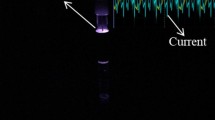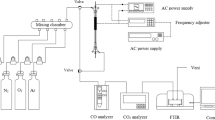Abstract
The feasibility of C3F8 abatement via combining nonthermal plasma with adsorption and/or catalysis is investigated in this study. In terms of the simultaneous combination of plasma, adsorption and catalysis (CPAC), three different configurations including A/C layer (adsorbent layer prior to catalyst layer), C/A layer (catalyst layer prior to adsorbent layer) and A/C mixture (adsorbent and catalyst are mechanically mixed) are adopted. For all the experimental tests conducted in this study, the gas stream consists of 500 ppm C3F8, 2% O2, and balanced N2. The experimental results indicate that C3F8 removal efficiencies depend on what kind of packing material is adopted (adsorbent, catalyst or both) and how the material is packed within the plasma reactor. The removal efficiencies obtained with different reactors are in the order as: CPAC (A/C layer; AC mixture) > CPA (plasma with adsorbent alone) > CPC (plasma with catalyst alone) > CPAC (C/A layer). The indentified products after treatment include CO2, CO, N2O and CF4. The formation of C2F6 is not observed in this study, which is encouraging since the global warming potential of C2F6 is actually higher than that of C3F8.









Similar content being viewed by others
References
Holzer F, Roland U, Kopinke F-D (2002) Combining of nonthermal plasma and heterogeneous catalysis for oxidation of volatile organic compounds Part 1. Accessibility of the intra-particle volume. Appl Catal B-Environ 38:163–181
Kim HH, Ogata A, Futamura S (2006) Effect of different catalysts on the decomposition of VOCs using flow-type plasma-driven catalysis. IEEE Trans Plasma Sci 34:984–995
Kim HH (2004) Nonthermal plasma processing for air-pollution control: A historical review, current issues, and future prospects. Plasma Process Polym 1:91–100
Chang MB, Lee HM (2004) Abatement of perfluorocarbons with combined plasma catalysis in atmospheric-pressure environment. Catal Today 89:109–115
Magureanu M, Mandache NB, Gaigneaux E, Panu C, Parvulescu VI (2006) Toluene oxidation in a plasma-catalytic system. J Appl Phys 99:123301
Chavadej S, Saktrakool K, Rangsunvigit P, Lobban LL, Sreethawong T (2007) Oxidation of ethylene by a multistage corona discharge system in the absence and presence of Pt/TiO2. Chem Eng J 132:345–353
Subrahmanyam Ch, Magureanu M, Renken A, Kiwi-Minsker L (2006) Catalytic abatement of volatile compounds assisted by non-thermal plasma Part 1. A novel dielectric barrier discharge reactor containing catalytic electrode. Appl Catal B Environ 65:150–156
Harling AM, Demidyuk V, Fischer SJ, Whitehead JC (2008) Plasma-catalysis destruction of aromatics for environmental clean-up: Effect of temperature and configuration. Appl Catal B-Environ 82:180–189
Chen HL, Lee HM, Chen SH, Chang MB, Yu SJ, Li SN (2009) Removal of volatile organic compounds (VOCs) by single-stage and two-stage plasma catalysis systems: a review of the performance enhancement mechanisms, current status and suitable applications. Environ Sci Technol 43:2216–2227
Manley TC (1943) The electrical characteristic of the ozonator discharge. Trans Electrochem Soc 52:5820–5828
Gindulytè A, Mass L, Banks BA, Miller SKR (2002) Direct C-C bond breaking in the reaction of O (3P) with flouropolymers in low earth orbit. J Phys Chem A 106:5463–5467
Acknowledgments
The authors gratefully acknowledge the financial support provided by Industrial Technology Research Institute of Taiwan (grant number 985914).
Author information
Authors and Affiliations
Corresponding author
Rights and permissions
About this article
Cite this article
Lin, B.Y., Chang, M.B., Chen, H.L. et al. Removal of C3F8 Via the Combination of Non-Thermal Plasma, Adsorption and Catalysis. Plasma Chem Plasma Process 31, 585–594 (2011). https://doi.org/10.1007/s11090-011-9303-6
Received:
Accepted:
Published:
Issue Date:
DOI: https://doi.org/10.1007/s11090-011-9303-6




